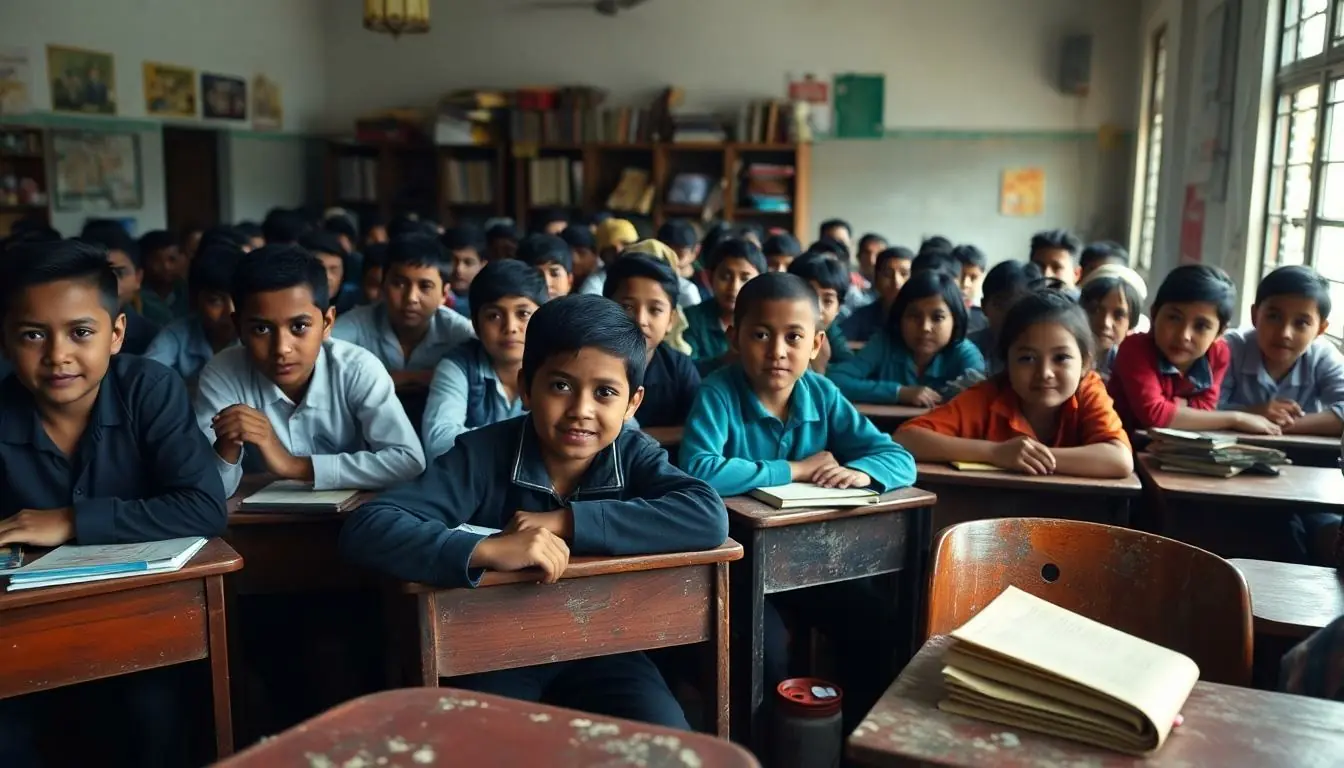Education today faces a rollercoaster of challenges that would make even the bravest thrill-seeker think twice. From outdated curriculums that seem to be stuck in a time warp to the ever-growing divide between technology and traditional teaching methods, the classroom experience is more chaotic than a cat in a room full of rocking chairs.
But it’s not all doom and gloom. These issues present a unique opportunity to rethink and reshape how students learn and teachers teach. With a sprinkle of innovation and a dash of humor, schools can transform into vibrant hubs of creativity and critical thinking. So buckle up as we dive into the wild world of modern education, where every problem could just be the next big breakthrough waiting to happen.
Table of Contents
ToggleOverview of Issues in Education Today
Modern education faces numerous challenges. Outdated curriculums often hinder teachers from providing relevant knowledge, limiting students’ engagement. A significant gap exists between technology advancements and traditional teaching methods. Many schools lack the necessary resources to integrate modern technology effectively, resulting in a disconnect in learning environments.
Additionally, disparities in funding affect educational quality across different regions. Schools in affluent areas typically enjoy better facilities, while those in low-income areas struggle with basic needs. This inequity in resource allocation creates a significant barrier to equal educational opportunities.
Teachers commonly experience burnout due to escalating workloads and insufficient support. Many educators express concerns about the high-stakes testing culture, which prioritizes standardized tests over individualized learning. This focus on testing can stifle creativity in the classroom and limit curriculum diversity.
Moreover, mental health issues among students have risen, requiring schools to adapt their resources and approaches. Increased anxiety, depression, and other mental health challenges affect student performance and overall well-being. Recognizing these issues, educational institutions increasingly seek to implement mental health programs and support frameworks.
Innovation in educational practices offers a pathway forward. Blended learning models and project-based approaches promote engagement and accommodate diverse learning styles. Emphasizing collaboration between educators, students, and communities sets a foundation for overcoming these challenges while fostering a more resilient educational landscape.
Socioeconomic Impact on Education

Socioeconomic factors significantly influence access to education and the quality of learning experiences. Many students in low-income areas face barriers that hinder their educational opportunities.
Access to Quality Education
Access to quality education varies widely across different socioeconomic backgrounds. Students in affluent areas often attend well-resourced schools, benefiting from advanced technology and experienced teachers. In contrast, students in low-income neighborhoods frequently deal with overcrowded classrooms and outdated materials. Research indicates that quality education is linked to better life outcomes, illustrating the long-term effects of educational inequity. Ensuring that all students receive high-quality education remains crucial for addressing these disparities.
Funding Disparities
Funding disparities create significant challenges in education. Schools in wealthier districts typically receive more funding per student, enhancing their educational offerings. Data shows that richer districts can spend up to two to three times more than their lower-income counterparts. Such differences lead to inequities in class sizes, extracurricular activities, and access to advanced courses. Policymakers must prioritize equitable funding solutions to level the playing field for all students, regardless of their socioeconomic status.
Technological Challenges
Technological advancements create both opportunities and challenges in education today. Navigating these challenges requires addressing specific issues that affect student learning and engagement.
Digital Divide
Access to technology isn’t equal across districts. Affluent areas typically have reliable internet and modern devices, while low-income neighborhoods often struggle with connectivity. This gap inhibits students’ ability to participate in digital learning initiatives. Across the United States, recent data shows that approximately 14 million students lack adequate internet access at home. Consequently, the digital divide widens educational inequalities, leaving marginalized students at a disadvantage in a technology-driven world.
Online Learning Effectiveness
Online learning effectiveness varies significantly among students. While some thrive in virtual environments, others find it challenging to stay engaged. A 2022 study revealed that only 40% of students reported satisfaction with their online learning experiences. Key factors include teacher presence, instructional design, and interactive elements. Additionally, students lacking self-discipline or support often struggle to succeed in fully online programs. This reveals an urgent need for schools to enhance online education quality, ensuring that all students benefit from flexible learning formats.
Mental Health and Wellbeing
Rising mental health challenges impact students’ experiences significantly. Increased stress and anxiety among youth correlate with academic pressures. Studies show that over 30% of high school students report chronic stress, often linked to performance expectations and workloads. Academic demands contribute to feelings of inadequacy, further exacerbating mental health concerns.
Support systems in schools play a vital role in addressing these issues. Many schools are implementing counseling services and mental health programs to provide students with necessary resources. Peer support groups enhance emotional resilience by fostering connections. Additionally, teachers are receiving training to recognize signs of distress among students. Effective intervention strategies can create a supportive environment, ensuring that emotional well-being becomes a priority in educational settings. Schools that prioritize mental health contribute positively to overall student success and engagement.
Curriculum Relevance
Curriculum relevance plays a crucial role in addressing contemporary educational challenges. Outdated content fails to engage students, leaving teachers struggling to connect lessons to real-world applications.
Adapting to Modern Needs
Schools must adapt to modern needs for curriculum effectiveness. Students today encounter rapid technological advancements and societal changes that require updated knowledge and skills. Incorporating elements like digital literacy and problem-solving into the curriculum helps prepare students for future careers. Data shows that 30% of high school students prefer hands-on learning over traditional lectures. Engaging students through relevant experiences fosters interest and builds essential skills. Revising curriculums to reflect current societal demands ensures education remains impactful and valuable.
Importance of Critical Thinking
Critical thinking is essential in fostering well-rounded students. Curriculums must prioritize skills that promote analytical thinking and creativity. Research highlights that students who engage in critical thinking exercises show improved problem-solving abilities and higher academic performance. Activities that challenge students to question, analyze, and create connections strengthen their understanding and application of knowledge. Schools that emphasize these skills prepare students to navigate complex issues in an ever-changing world. Encouraging critical thinking ensures students become informed, innovative thinkers equipped for future challenges.
Addressing the issues in education today requires a multifaceted approach that prioritizes equity and innovation. Schools must adapt to the changing landscape by integrating modern technology and relevant curriculums that engage students effectively. By fostering supportive environments and addressing mental health needs, educators can create spaces where all students thrive.
Policymakers play a crucial role in ensuring equitable funding and resources, helping to bridge the gap between affluent and low-income areas. With collaboration among educators, students, and communities, the potential for transformative change in education is within reach. Embracing these challenges can lead to a more resilient and effective educational system that prepares students for the complexities of the future.





